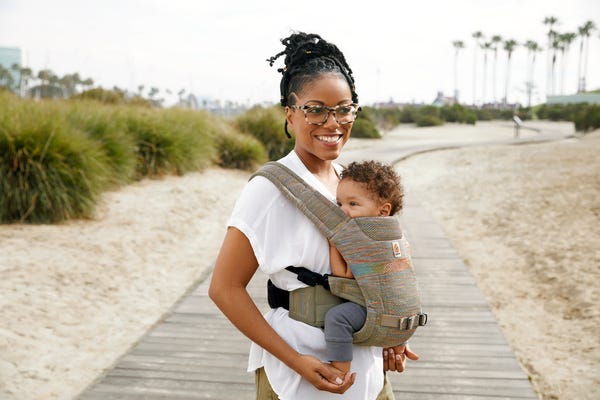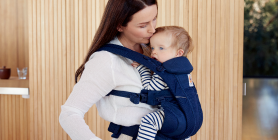
October 07, 2014
To celebrate babywearing week, we reached out to our friends at Babywearing International. BWI is a non-profit group that helps all the parents wear all the babies! We love the work they do promoting babywearing as a universally accepted practice (thank you!), with benefits for both child and caregiver. They provide education and support to parents, caregivers, and educators through outreach activities (check out some activities in your area). At the heart of BWI is their network of chapters run by Volunteer Babywearing Educators serving their local communities, these educators can help you with everything from which carrier is best for you to how to do a back carry.
So, when we were looking for babywearing tips to share, naturally we reached out to this amazing network to get their tips from experience! We’ve grouped their tips by topic, so you can easily find what you are looking for! Here are a few tips broken down we’ve broken down by section of most frequently asked questions.
Babywearing | Things to Know Beforehand
As much as we’d all like to believe babywearing is intuitive, there are a few things to know that can set you up for success. Here are a few tips to help you get started if you’re brand new to babywearing.- If you can, try on some carriers or take a class before you buy to get an idea of what baby carrier styles or features may be important to you. Making an informed choice goes a long way to starting you off on the right foot.
- Get familiar with your carrier ahead of time. Before baby comes, or before you put baby in, take the carrier out of the box and become familiar with the features. How to buckle the waist, and put the carrier on confidently.
- Start when baby is fed and has a clean diaper instead of when baby is upset or hungry.
- Stay calm. Okay, I know this can be hard when you’re nervous and just getting started. Babies are super smart and quickly pick up on our nervousness.
- Move, move move. Babies need movement to calm their bodies. It’s what they’re used to in the womb, and then when they’re born we stand and make small movements or pat instead of the larger movements they’re used to. Don’t be afraid to start walking briskly.
- Talk to baby, reassure them with your voice. Narrate what you’re doing. Your voice is calming to them, and let’s them know everything is okay. It’s also really beneficial for their brain growth, expressive and receptive language.
- Get outside, change the scenery. This can be a great way to vary what baby is seeing and the fresh air is beneficial to you both. It doesn’t have to be a big outing, a walk around the block will generally suffice.
- Practice. It’s a new skill, that may be unfamiliar to you both. Using the carrier for you and baby is muscle memory. If you’re not successful, go back to it when you’re in a better space.
- Know that throughout different ages/stages, the babywearing relationship changes. Just like sleep and feeding. Your positions in the carrier, or even carrier styles may change depending on your or the baby’s needs.
- Get help if need be. There are babywearing educators, as well as babywearing groups and communities located all over the country who are happy to help you troubleshoot your carrier, and give you tips and support along the way for wearing your baby.
Babywearing | Newborns & Safety
Babywearing your newborn is different than carrying around an older baby or toddler. A newborn’s neck and body need extra support, and they’re just overall more fragile than older babies.- When wearing a newborn or smaller infant, it helps to buckle the waistband higher on your waist to help get baby to kissable level. [BWI of Greater Austin]
- Visible and Kissable keeps baby safe and happy. [BWI of Knoxville]
- Always make sure baby has two fingers width between chin and chest to keep airway open and clear. [BWI of Knoxville]
Babywearing | Back Carry
What is back carrying? Well, it’s when you place your baby in a carrier on your back. Around 6 months old, babies can be comfortably carried on your back. Back carrying allows for better mobility and freedom of movement while keeping your little one close and secure. Ensure proper support and positioning, and always follow the guidelines provided by the baby carrier manufacturer for a safe and enjoyable experience.- When learning to back carry, practice over a bed or have a spotter to assist you. [BWI of Knoxville]
- Get a deeper seat in a back carry. After putting carrier on and adjusting mostly – Reach under your armpit and back to grab baby’s leg/thigh on one side and reach up and over your shoulder to grab the shoulder strap closer to the top of the body of the carrier. Then lift and rotate, pulling gently up and forward on baby’s thigh while gently bouncing and pulling up on the shoulder strap. Switch sides and repeat. Snug down the shoulder straps as needed to get a more secure fit after this has settle baby deeper in the seat. [BWI of Phoenix]
- Uncertain about getting baby on your back by yourself? Lay your carrier out on the couch or bed, and then sit baby on top of it. Then sit in front of the carrier, buckle it on your waist, and then bring the loosened shoulder straps up onto your shoulders. Scoot baby towards your body, tighten the shoulder straps, and bounce baby down into a deep seat. Tighten again and you’re ready to go! You can reverse the process to get baby out, until you and baby are more comfortable with back wearing! [BWI of Greater Boston]
- When doing a back carry, lean forward a bit so baby’s weight is off the carrier and pull the “slack” out of the shoulder straps, tighten them and then adjust the chest clip for more comfortable wearing. [BWI of Greater Austin]
Babywearing | Safety and Comfort
When babywearing, ensuring comfort is essential for both you and your baby. Here are a few tips and tricks to ensure a more comfortable and safe experience.- If you find your shoulder straps slipping off your shoulder, loosen the shoulder straps a bit, tighten the chest/back clip and then retighten the shoulder straps. [BWI of Greater Austin]
- If you’re having difficulty reaching the chest clip while doing a front carry, loosen the shoulder straps, fasten the chest clip, pull it over your head, then tighten as usual. [BWI of Central PA]
- Keep your carrier’s sternum strap low. It should match your child’s car seat and go armpit to armpit. It reduces any under arm rubbing and provides a secure point to counterbalance any weight. [BWI of Grand Rapids]
- Make sure your waistband is nice and snug! Otherwise baby’s bottom may slip down into the waistband making it less comfortable for you! [BWI of Greater Austin]
- If the shoulder straps are rubbing under your arms, try positioning the back clip lower on your back, at or below your shoulder blades. [BWI of Greater Austin]
- If the shoulder strap clips are bothering you, take a pair of suck pads and attach them around the straps where the buckles are. Still able to tighten or slide them to loosen but it provides some cushion if the buckles are irritating you. [BWI of Phoenix]





















